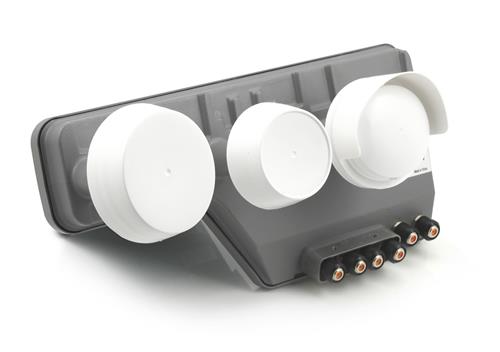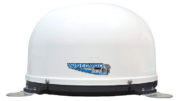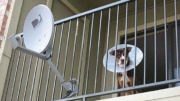LNB. It’s one of those terms that you hear all the time with satellite technology and no one seems to want to define. So, let’s get down to business.
The easy definition
The easiest way to define “LNB” is “the thing at the front part of a dish. It’s actually the only part of the dish that does any work.
What we call a satellite dish is more properly referred to as a high-frequency parabolic antenna. A parabolic antenna focuses all the signals it receives onto a single point. It does this with a large, curved reflector, like this:
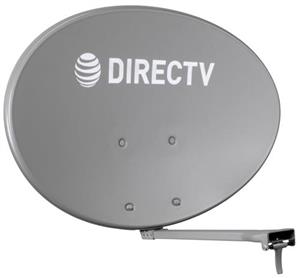
This reflector is oval because it actually needs to focus different signals on a slightly different point, but that’s probably not important right now. If you look at the way a parabolic antenna works from the top, it looks like this:
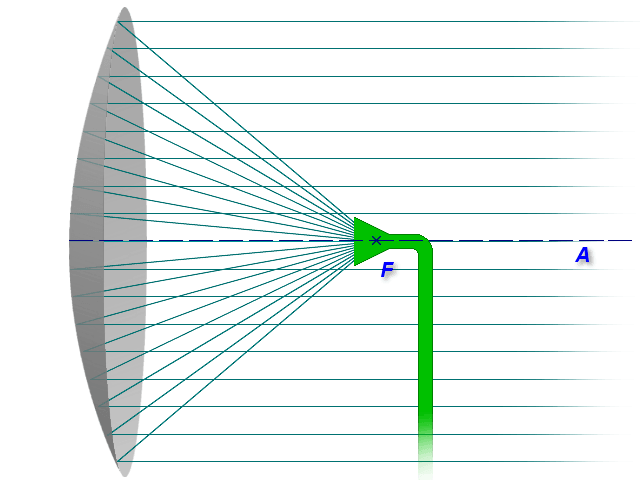
All the signals converge where the yellow dot is, and that’s where we put the LNB.
What are the parts of an LNB?
Feed Horn
The only part of an LNB you can actually see is called the feed horn. It’s the part with the white plastic cap. It acts as sort of a funnel for the signals, focusing them even further on an even smaller point. If you look at this LNB from the top, you can see how it looks like a pipe that gets narrower and narrower.

Receiving element(s)
This is actually the part that does the work. It’s an antenna the size of your pinky nail that receives signals from satellites. It can be so small because satellite dish frequencies are so high. The higher the frequency, the smaller the waves and the smaller the antenna you need.
Most satellite dishes for the US market have at least three receiving elements. DIRECTV’s most complex LNB, the Legacy Reverse Band 5 dish, has 7 receiving elements covering 5 locations, covered by three feed horns.
Low Noise Amplifier(s)
You can imagine that signals coming from 22,000 miles away would be pretty weak. They certainly are. They’re too weak to travel down a cable. So, they’re amplified before they leave the dish. It’s important to point out that the amplifiers used are very low noise models. You need low noise amplifiers because the signal itself is so weak. If you added noise, you would risk losing those signals.
Block Downconverter(s)
There’s another issue with satellite signals: Those high-frequency signals don’t travel on cables very well. So, they are “downconverted.” The original signals, which are in the ranges between 12,000 and 40,000MHz, are translated down into a range between 950 and 2150MHz. This is much better for traveling through a traditional coaxial cable
Carrier-specific hardware
All modern dishes for US customers have some sort of other hardware in there as well. Most DIRECTV dishes have a multiswitch built in. Multiswitches allow more than one receiver to share the satellite dish. Modern multiswitches do far more, remodulating the signal and using two-way communication. This is how they manage to put everything you need for multiple receivers on just one wire.
DISH equipment isn’t quite so complex, but today’s DISH LNBs have all the hardware needed to make a Hopper system work properly. Just like DIRECTV hardware, DISH’s Hopper sends satellite signals only to one master DVR which then sends them out to other boxes over a network.
Do I have a choice of LNBs?
For both DIRECTV and DISH, you really should choose only the LNB that works for you. In the past there were a lot of choices but now it’s become very standardized. Here’s the breakdown:
| Who are you? | What do you need? |
|---|---|
| DIRECTV residential customer | Reverse Band Slimline-3 |
| DIRECTV commercial customer | Reverse Band Legacy LNB with SWM-30 |
| DISH residential customer | Eastern Arc or Western Arc Hybrid LNB |
Solid Signal sells other LNBs but they are intended as replacements for broken LNBs, or for specialized setups. If you’re planning a new installation, these are the only ones you should consider.
Find everything you need at Solid Signal
When you shop Solid Signal, you’ll find everything you need for your satellite TV project. Whether you’re a DIY type or experienced installer, you’ll find the tools and accessories that are right for any project. Have questions? Use our Facebook group or call us at 888-233-7563.

